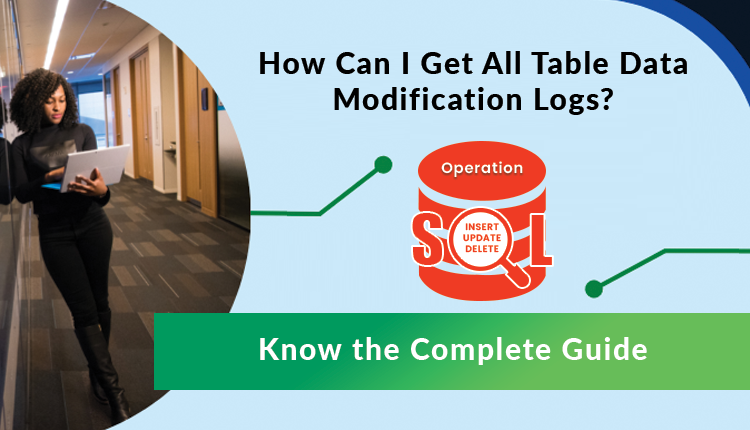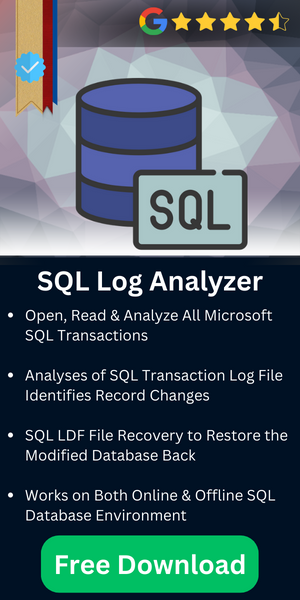How Can I Get All Table Data Modification Logs? Know the Complete Guide

Have you ever wondered about how to maintain a record of every modification made to a table within a SQL database? If yes, then this blog post is the best place for all your answers! We will discuss the idea of table data modification logs, as well as the justifications and methods for keeping track of them.
Overview of Data Modification Logs For Tables
Table data modification logs serve as a kind of journal, documenting any changes and additions made to your data. They aid in your comprehension of the changes that were made, who made them, and why. If you have access to these logs then you can track and monitor any modifications without difficulty.
Let’s now investigate one user query regarding using data from all SQL tables.

Reasons For Tracking Table Data Modifications Logs
In this blog section, we detail the reasons that focus on this requirement. Let’s take a closer look at the most common causes of this need:
-
- Data Integrity : Maintaining the integrity of data is the utmost important thing for any organisation or business. Sometimes, there is a need when users look for a solution to get all table data modification logs.
- Troubleshooting and Debugging : When the issue arises within a database, it is the most important thing to identify the root causes quickly. It is crucial to maintain data integrity and safety.
- Compliance and Auditing: Many industries such as licences and healthcare have strict data backup rules and regulatory requirements. In such cases, tracking all the data is a crucial part for maintaining data integrity and security.
In the upcoming section, we will discuss methods for tracking all table data changes. Now, let’s start looking for effective ways to do this.
Methods to Obtain Table Data Modification Logs
There are multiple ways to track all data modification logs in SQL Server databases, depending on which database manifest system you are using. Here are a few typical techniques:
- Enable Change Data Capture (CDC)
- Create Triggers
- Access and Query CDC Data
- Third party Tool
In the next section, we will discuss the manual solutions to track all table data modification logs.
Also Read: How to Shrink MS SQL Transaction Log File With Ease
Method 1 : Manual Method to Track All Data Modifications Logs in SQL
This manual approach provides users to access and track all data changes or modification logs in SQL Server. Nevertheless, for certain users, it could be a difficult process. If you have sufficient time to complete them, then proceed with the next step.
1: Enable Change Data Capture (CDC)
Microsoft SQL Server provides a feature called change data capture (CDC). It helps to capture and monitor any modifications made to the data in the database. As it works, it reads the database transaction log and displays all the relevant details about the changes.It provides a simple means for you to obtain a history of the table’s actions.
Follow the below mentioned steps to track the modification logs :
Step 1. First, right-click on the database in SQL Server Management Studio (SSMS).
Step 2. Then, Select “Tasks” and click on “Configure Change Data Capture.”
Step 3. Turn on CDC for the tables that you want.
Step 4. Now, pick the right options for capturing and cleaning up data.
2: Create Triggers (if CDC isn’t used or for custom logging):
If a company has special needs or uses a different database, they can design their own method of managing all data. To save the crucial information about any modifications to the data, they must create custom solutions, which entail writing unique code or scripts.
- To keep an eye on tables, we use something called Triggers. Triggers are like instructions that watch out for when someone adds, changes, or removes stuff from a table.
- Within the triggers, we write down some rules to grab important information like when it happened, who did it, and what was there before and after the change. We then save all this info in a special table made just for keeping track of these actions.
3 : Access and Query CDC Data (if CDC was enabled):
After you enable change data capture (CDC) and choose particular tables, you can use the CDC functions to view and query changes. It is an easy way to see or retrieve changes made to the tables. With this, you track how things have changed over time.
How to Access and Query CDC Data:
- First, you must have to use standard SQL queries to retrieve the CDC data from the system-generated CDC tables.
- After this, insert the CDC tables with the original tables of SQL to see the changes in context.
The manual methods to get all the table data modification logs is a very tedious and time consuming task. Also, they require good technical expertise to complete the whole process without any data loss. However, there is a more convenient way for a user to view all changes in table data.
Method 2 : Alternative Solution to Track All Table Data Modification Logs
If it is too difficult to perform the steps manually, you can use a third party automated tool to quickly access the full text to change the table. You can view, read and analyse all MS SQL Server transaction logs or connection information such as when resources are added, changed or removed. It is the convenient way to check the SQL Server log (.ldf) file for significant changes to the record. Additionally, it works whether your SQL database is online or offline.
The best part is that you don’t even need to install the MS SQL Server application to open and view all the action in the transaction log.
Best Tool to Analyze SQL Logs
In order to analyze SQL logs for forensic related work, legal compliances, get back all modified logs if deleted or damaged, automated solutions work like magic. Users can trust the best in class SQL Log Analyzer Tool to get the best customized results for their SQL Log data files.
Conclusion
We discussed the solutions and the reasons to track all the table data modification logs in this blog post. The reasons mentioned here necessitate urgent access to the SQL table data. The manual solutions mentioned here look perfect for viewing the modification logs. However, the limitations restrict its usage. Hence, you can use a third-party tool for tracking the data in SQL modification logs with complete data security.
